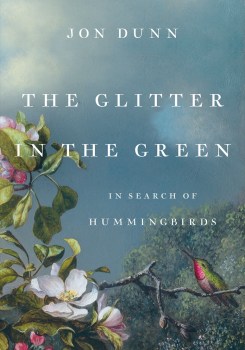The Fiery Hummingbird Of Isla Robinson Crusoe
The Juan Fernández Firecrown hummingbird is a magnificent, isolated castaway that had evolved to look unlike others of its kind.
The following is an excerpt from The Glitter in the Green: In Search of Hummingbirds by Jon Dunn.

The Glitter in the Green: In Search of Hummingbirds
As a young boy reading Robinson Crusoe, I was blissfully unaware of any of the book’s subtexts, but I was definitely taken with the story of a man forging a new life on a remote island. Defoe’s book was at least part of the genesis of my yearning to do just that for myself one day in my future. In time, I came to hear about a hummingbird that lived on the island upon which Alexander Selkirk had been marooned for four years—the Juan Fernández Firecrown, a magnificent, isolated castaway that had evolved to look quite unlike any others of its kind. Indeed, as lately as the 1980s scientists believed there were not one, but two species of hummingbird endemic to the island, so different and strongly marked were the plumages of the male and the female birds of what, in time, we came to recognize as just one species after all.
The male birds are clad entirely in rich, rufous chestnut plumage, with a gold and crimson forehead. Unusually for a hummingbird, where females are normally dressed in muted shades of green and off-white, suitable for camouflaging them during the critical nesting period, the female Juan Fernández Firecrowns have plumage that is as beautiful, if not more so, than that of their mates. Their upperparts are the clear blues and greens of the surrounding ocean waters, their underparts snow-white and ermine-spotted with spangles of metallic emerald. The absence of significant predators in their isolated island home would have allowed this exuberant hummingbird fashion statement to evolve; but the arrival of rats, cats, and, with the eventual colonization of the island by mankind, more alien species besides, all made for a new and unwelcome chapter in the Juan Fernández Firecrown’s history.
My journey into the Pacific began with me standing, alongside a small group of other passengers, outside a small aircraft hangar on the periphery of the airport in Chile’s capital, Santiago, nervously eying an elderly Dornier Do 228. We were waiting for news from Isla Robinson Crusoe—the weather there had delayed our flight by over an hour already.
The alternative, a passage by sea, had appealed to the romantic in me. Selkirk arrived on the island by boat, and I would have liked to do so too. Isla Robinson Crusoe is served, however, by a Chilean naval vessel whose irregular timetable, try as I might, I could not be entirely sure was even remotely accurate. My attempts to book passage were met with maddeningly vague responses. On the last leg of my hummingbird travels, I needed certainty—I had a flight to catch to Argentina’s southernmost city, Ushuaia, in a little over a week’s time, and I could not afford to find myself stranded, like Selkirk, for an indefinite period of time on an island. It would have to be the plane—if the weather relented.
So different and strongly marked were the plumages of the male and the female birds of what, in time, we came to recognize as just one species after all.
Abruptly, and with no great ceremony, we were invited to board our aircraft.
“The weather is clear there,” the captain announced. “We must leave, now.”
Three hours later we landed, back where we started, in Santiago.
We had got halfway to Robinson Crusoe before the island radioed the captain to inform him they were smothered once again in a thick bank of fog. The decision was made for him, in that moment—we had to return to a clear runway. The air of gloom on board the plane was pervasive.
“We’ll not get there today,” prophesied one of the local passengers.
“We’ll be here for days now.”
We filed back into the small terminal building, informed that our luggage would be unloaded shortly. We could help ourselves to coffee if we were thirsty. My coffee was not cool enough to drink before the captain repeated his previous exhortation. “The weather is clear. We must leave, now.”
With the eventual colonization of the island by mankind, more alien species besides, all made for a new and unwelcome chapter in the Juan Fernández Firecrown’s history.
While I, by now, had little grounds for optimism that we would actually land on Robinson Crusoe, I was at least relieved that we were trying again. My relief blossomed, some three hours later, as the boxy plane banked around the end of Robinson Crusoe to make its approach to the cracked and potholed short runway that serves the island. The changeable maritime climate might mean that I would struggle to leave Robinson Crusoe on schedule at the end of my stay, but at least when I did leave I ought now to do so having spent some time with the Juan Fernández Firecrowns.
Excerpted from The Glitter in the Green: In Search of Hummingbirds by Jon Dunn. Copyright 2021. Available from Basic Books, an imprint of Hachette Book Group, Inc.
Jon Dunn is a nature history writer and photographer based in Shetland Isles, United Kingdom. He’s author of The Glitter in the Green: In Search of Hummingbirds (Basic Books, 2021).